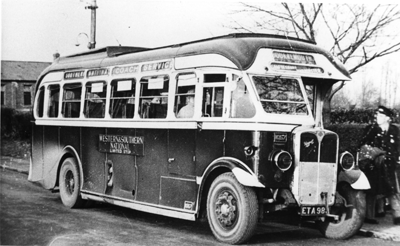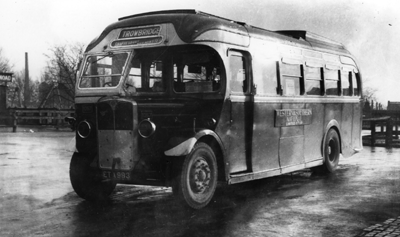|
|
||||||||||||||||||||
|
||||||||||||||||||||
| WEB NEWS 28 | ||||||||||||||||||||
|
In this issue of WHOTT Web News we take a brief look at Unforgotten Journeys, The Green Linnet and Bere Regis Coaches. |
||||||||||||||||||||
|
Unforgotten Journeys - Over the past two years WHOTT’s News! has featured a number of articles in response to the question “WHOTT’s your favourite route?”. The series continues with the following recollections from John Cole, Friend 152.I dithered far too long to be able to participate in the poll of WHOTT’s favourite routes, and the fact that no less than twenty of my potential favourites turned up on the list – not to mention many more which did not – excuses my hesitation. Of course Western National’s 93 was there and how I enjoyed that account of a present day trip from Plymouth to Dartmouth (WHOTT’S News! 23). But I think my vote, bringing it up to equal third, would almost certainly have gone to the 83 service from Plymouth to Tavistock and I can cheat with additional votes to the rural services which branched off this route. It is some years since I last sampled this route and I’m not quite sure how young I was on my first trip. So if I cannot give a modern day account of this little-changed service dating from Devon Motor Transport days, let me run through the fare stages in the Western National South Devon and East Cornwall timetable for September 1937 – July 1938. I have a picture of open staircase Leyland TD1 - National 2591 (DR4034) - ‘crossing Dartmoor’ in April 1929. Actually it wasn’t, a common misconception made by myself, and others is that Roborough Down constituted part of the Moor, whereas it is detached by several miles. Some of these open staircase Leylands survived the Second World War but I cannot remember them, and the familiar vehicle for the route, at least post 1945, was the Bristol K5G. Starting point was St Andrew’s Cross, Plymouth and one might have a tram for company as the bus progressed to the first stage point at the Technical College (or library on the other side of Tavistock Road). At the top of North Hill the stopping point was the Blind Institution and the adult fare of three halfpence was probably still in vogue at the end of the ‘forties. Next came Plymouth’s other shopping centre at Mutley Plain, stopping outward at Seaton Avenue by the Post Office or the hugely popular Goodbody’s café on the return. There followed Seymour Road and Hender’s Corner to the 1930’s city boundary which crossed the road just beyond Hartley Reservoir. Manadon Lodge followed and then the ‘village’ of Crownhill. The fare table gives Tamar Hotel or Plumer (and also Seaton on the next page) Barracks but the timetable quotes Tamar Hotel outward and Widey Café inward. Green fields and views to the east – the china clay workings at Lee Moor being conspicuous – would have been apparent beyond Hartley. But north of Crownhill it became increasingly rural. Convalescent Home, George Hotel and Grant’s Garage might now be hard to place but the Lopes Arms in Roborough village possibly still exists. And so on to the breathtaking scenic Roborough Down. Indeed it ‘felt’ like Dartmoor, unfenced with ponies apt to wander in front of the bus and with western flanks of Dartmoor prominent on the one hand and views far into Cornwall, such as the St Austell china clay workings, on the other. Stopping points on this section were Maristow Lodge, Clearbrook Road and Whitestones. Want to read the full story, then become a member and receive our quarterly newsletters. |
||||||||||||||||||||
|
||||||||||||||||||||
|
Bere Regis & District - In the 1930s - 1960s, large areas of Dorset were served by the green buses of either Southern National, Western National or Hants and Dorset, with some red Wilts and Dorset routes in the north east of the county. However, a large part of the county was served by a much less common coloured fleet - the two-tone browns of Bere Regis and District. The following summary has been drawn from the information available on the www.countrybus.co.uk website. Our kind thanks are extended to Peter Roberts for allowing reproduction. The Bere Regis Motor Services had been started by George Vacher in 1919, with routes to Dorchester on Wednesdays and Saturdays and to Poole on Mondays and Thursdays. By 1927 there were two motor vehicles and additional routes were being run to Blandford, Bournemouth, Wimborne and Wareham. One of Vacher's drivers, Reg Toop, (who had been driving for Vacher since the age of 14) decided, however, to set up in competition, starting with a 14 seat Ford Model T on 29th October 1929, and - when George Vacher sold out to Hants and Dorset in 1930 - changed his fleet name from 'Pioneer' to 'Bere Regis & District'. From this small start, the firm grew to become the largest independent operator in Dorset.
After the war, with many vehicles being time-expired, it became
necessary to think about renewing the vehicle fleet. Ten new
Bedford OB's arrived in 1946, as well as a mix of second hand
vehicles, including two ex-Chest To receive quarterly editions of 'WHOTT News' then why not become a friend of WHOTT.
Commer Avenger REV682, an Essex registered vehicle prior to acquisition by Bere Regis and District, parked in Dorchester. Note the large semaphore indicators. |
||||||||||||||||||||
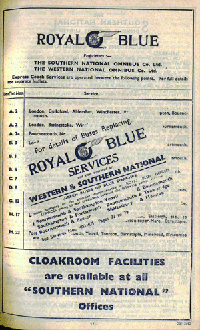 The
Green Linnet - Colin Morris (Friend 61) When I joined the
‘Blues’ in the early 1950s if someone mentioned ‘The Green Linnet’
they were not talking about the little bird with the beautiful song
but a BUS. “A bus”, I hear you ask , "what is a coach company
who run long distance express services doing with a bus?" Let
me explain. The
Green Linnet - Colin Morris (Friend 61) When I joined the
‘Blues’ in the early 1950s if someone mentioned ‘The Green Linnet’
they were not talking about the little bird with the beautiful song
but a BUS. “A bus”, I hear you ask , "what is a coach company
who run long distance express services doing with a bus?" Let
me explain.During WWII, Royal Blue was forced to cease express services but they did carry on with a number of stage (bus) services. One of these services ran twice daily from Bournemouth to Trowbridge, along part of the pre-war Associated Motorways route from Bournemouth to Cheltenham. Royal Blue vehicles were used and conductors were carried. The service was numbered 405. In 1946 stage services ceased except for service 405, which continued and operated two daily departures from Bournemouth but terminating at Shaftesbury, using Royal Blue vehicles and carrying conductors. A Royal Blue driver from the Bournemouth depot operated the service, on a split shift basis; the conductor also came from Bournemouth. The departures from Bournemouth were timed for 0930Hrs and 1630Hrs. In 1949, service 405 was discontinued and a new service 248 was instituted. This service operated with two daily departures from Bournemouth through to Trowbridge. There was a corresponding service from Trowbridge. No longer was a Royal Blue vehicle allocated to this service but a Southern National bus; conductors were still required. The vehicle in question was a Bristol J of 1935 vintage, registration number BTA454, fleet number 164. 164 was originally a Royal Blue coach downgraded to a bus and rebodied in May 1949. In September 1949, service 248 commenced with 164 in splendid Southern National green and soon gaining the nickname ‘The Green Linnet’. A corresponding service was run from Trowbridge depot using Western National vehicle 207 (ADV113) a Bristol first registered in 1936 Want to read the full story, then become a member and receive our quarterly newsletter. |
||||||||||||||||||||
|
|
||||||||||||||||||||
|
Two views of Royal Blue AEC Regal 1057 on the 405 service connecting Trowbridge and Bournemouth. 1057 is seen in wartime livery with blackout shields on the lights and white paint on the vehicle corners. The Royal Blue fleetname is covered with a board reading: Western and Southern National Limited Stop. Left: 1057 en route to Bournemouth c. 1942. [ Colin Billington Collection] Right: 1057 in Trowbridge, September 1942. The sticker on the nearside front bulkhead window provides the same route information as shown in the timetable above. |
||||||||||||||||||||
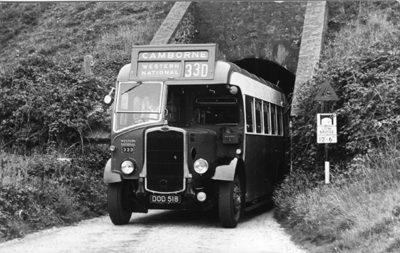 Plus: Plus:Commercial Points of Interest John Hobbs Remembered Western National's Camborne depot in the early 1950s - The memories of a small body - 2 Just the Ticket -11 Points of View
333 squeezes under the main line at Brea on the 33D Pencoys to Camborne service. |
||||||||||||||||||||
|
Would you like to see the full magazine? If so, please consider becoming a Member and we’ll send current year copies right away. Alternatively individual back numbers can be purchased at £2 each by request. Our Shop postal rates apply. |
||||||||||||||||||||
| Web News Index | ||||||||||||||||||||
|
|
||||||||||||||||||||
|
© Copyright The West Country Historic
Omnibus & Transport Trust |
||||||||||||||||||||

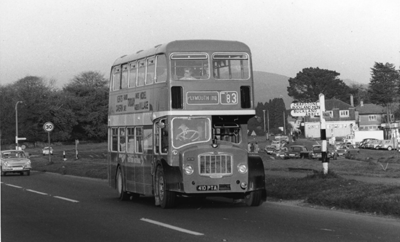
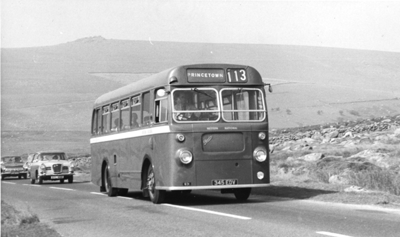
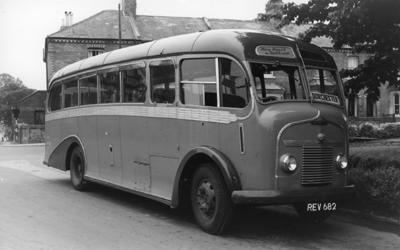 er
Leyland Titan TD4s, AFM518/519, which were Bere Regis's first
double-deckers. These were usually employed on the Bere Regis
- Poole, Bere Regis - Dorchester and Dorchester - Sherborne routes.
Another Titan TD2, YG710, came in 1948, and it is thought that three
ex-London STLs (CXX289, DGX286 and BLH793) were acquired in 1954.
Bere Regis's only other double deckers were two more modern looking
1947 Leyland PD1s, FCG526/527, obtained in from Hants & Sussex in
1949, and remaining in the fleet until 1960. These post-war
years up the early 1950s were the halcyon years for bus operations.
er
Leyland Titan TD4s, AFM518/519, which were Bere Regis's first
double-deckers. These were usually employed on the Bere Regis
- Poole, Bere Regis - Dorchester and Dorchester - Sherborne routes.
Another Titan TD2, YG710, came in 1948, and it is thought that three
ex-London STLs (CXX289, DGX286 and BLH793) were acquired in 1954.
Bere Regis's only other double deckers were two more modern looking
1947 Leyland PD1s, FCG526/527, obtained in from Hants & Sussex in
1949, and remaining in the fleet until 1960. These post-war
years up the early 1950s were the halcyon years for bus operations.